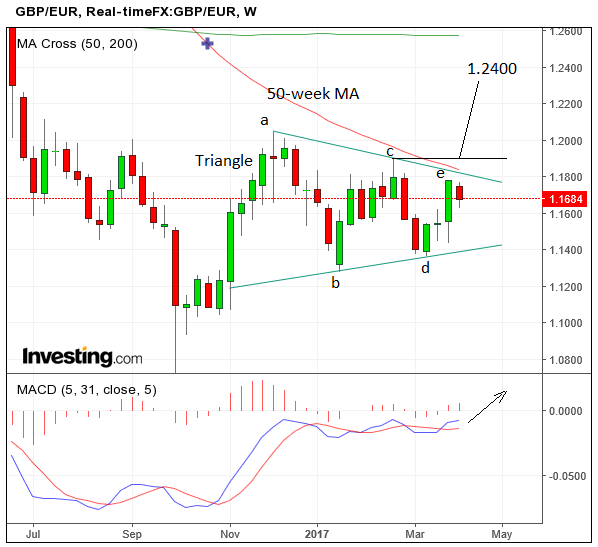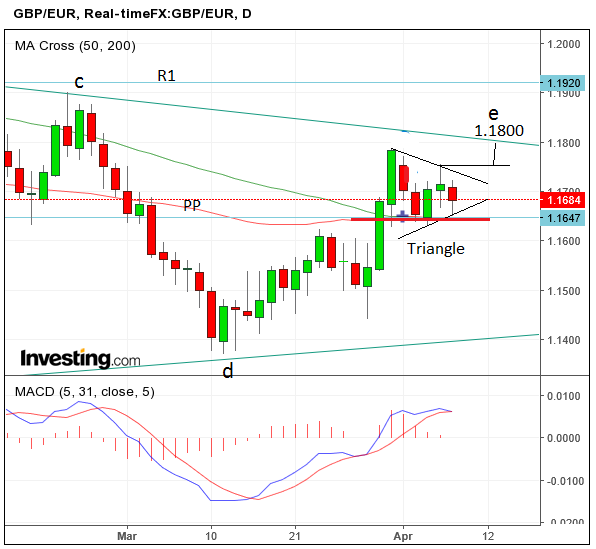The Pound Forecast to Rise to 1.24 vs Euro
- Written by: Gary Howes

Pound Sterling maintains positive momentum against the Euro and our studies of the near-term timeframe suggest the outlook continues to favour Sterling.
Looking at the weekly charts, the Pound to Euro exchange rate has been moving within a relatively tight range over the last six months since the Pound rebounded from the October 2016 lows.
The range has evolved into what appears to be a symmetrical triangle which it is close to completing, as it is currently forming wave ‘e’ and triangles usually have a maximum of five waves (a-e).
Although it is too early to say which direction the triangle will eventually breakout in, we can use clues from the momentum study in the bottom pane which looks more likely to move higher than lower.
A rise in momentum would be indicative of an upside breakout.
For confirmation of an upside breakout, we would want to see a move above the February highs at 1.1903.
This would generate an upside target at 1.2400, which is equivalent to 61.8% of the height of the triangle extrapolated higher from the break.
61.8% represents the ratio of the golden mean, an important mathematical principle underlying forms in nature and applicable to financial markets, according to some technical analysts.
Drilling down to the daily chart - which covers a shorter-term timeframe - and we see that the exchange rate was moving up to the top of the triangle but that it stalled and has been moving sideways for the last week.
It also seems to be forming what appears to be a triangle pattern of a much smaller scale.
We see a possibility of a breakout higher to the upper border line at 1.1800.
Such a move would gain confirmation from a break above the 1.1756 highs.
The slightly bullish bias is supported by the strong tripartite cluster of support levels lying at the base of the triangle in the 1.1640s, which is composed of the monthly pivot (PP), the 50 and the 200-day moving averages.
This will be a very difficult level to break below due to these three lines since moving averages and pivots are not just indicators of long-term value or equilibrium but also present obstacles to the trend on charts due to traders using them as entry levels, for fading the trend.
Big Data Releases that Could Shake the Outlook
There are two major data releases due out of the UK ahead of the eater holiday which should attract some attention, particularly as politics are likely to take a back seat.
“In the run up to Easter, we suspect we will see a relatively quiet period for political news, with few top tier political events,” says Victoria Clarke at Investec in London.
“With the Easter holidays approaching and with UK Parliament in recess, there is likely to be little by the way of major developments in Brexit talks over the coming week.”
CPI inflation figures for March came out Tuesday morning; markets expected to see inflation at 2.3%, unchanged on the previous month’s reading.
This is exactly what they received and Sterling was seen holding its uptrend.
"We would not read too much into today’s release since the drop in inflation is likely to be temporary and inflation is likely to rise further over the course of this year," says a note from UniCredit Bank, "we expect an annual average of 2.4% for the UK headline CPI in 2017."
More prices rises are therefore likely and this could well support Sterling longer-term, but for now, the bulls will have to wait.
Labour market data is the next big data event foreign exchange traders will be keeping an eye on and is due for release at 09:30 on Wednesday, April 12.
The claimant count is expected to fall by 3K while the unemployment rate is forecast to remain static at 4.7%.
But watch average earnings data as this is what gives a really good gauge as to the health of the economy and the potential spending power of the UK consumer.
Average earnings with bonuses included is forecast to publish at 2.2%, unchanged on the previous month’s reading.
If the figure comes in higher we would imagine the Pound will move accordingly and we would watch for the GBP/EUR exchange rate to edge up towards the 50-day moving average 1.1841.
Disappointment will likely be punished and we would anticipate GBP/EUR falling back towards 1.14.
Data, Events this Week for the Euro
Analysts will be carefully following French election opinion polls in the coming week to assess the probability for a Le Pen win.
The campaign period is drawing to a close but we have noted the race has turned into a four-way shoot out with the emergence of Jean-Luc Melenchon as a contender.
How does Melenchon impact the chances of a Le Pen win? Does he suck support away from the moderate front-runner Emmanuel Macron? If so then the markets could become nervous.
The more likely Le Pen is to win, the weaker the Euro will become as she may take steps to weaken European integration or even take France out of the EU altogether.
While the likelihood of a Le Pen win remains slim markets have not completely discounted the fact.
If further discounting were to occur over coming days and weeks then the Euro might edge higher.
"The development of political risk premia in the eurozone should be positive for the Euro, as we think it should start to reduce, however, the ECB’s communication stands as an obstacle for any rebound in the near-term," says a note released by UniCredit at the start of the new week.
Tuesday saw the release of the ZEW Sentiment survey, which asks 300 financial experts for their views on the outlook for the Eurozone economy, showed a rise in the balance of positive responses versus negative responses, to plus 26.6 in April from +25.6 in March.
The market had expected the survey to show a moderate fall to 25.0 and the Euro was seen firmer against the likes of the US Dollar and other major currencies as a result.
Expect markets to place more importance on politics than economics over coming weeks.







